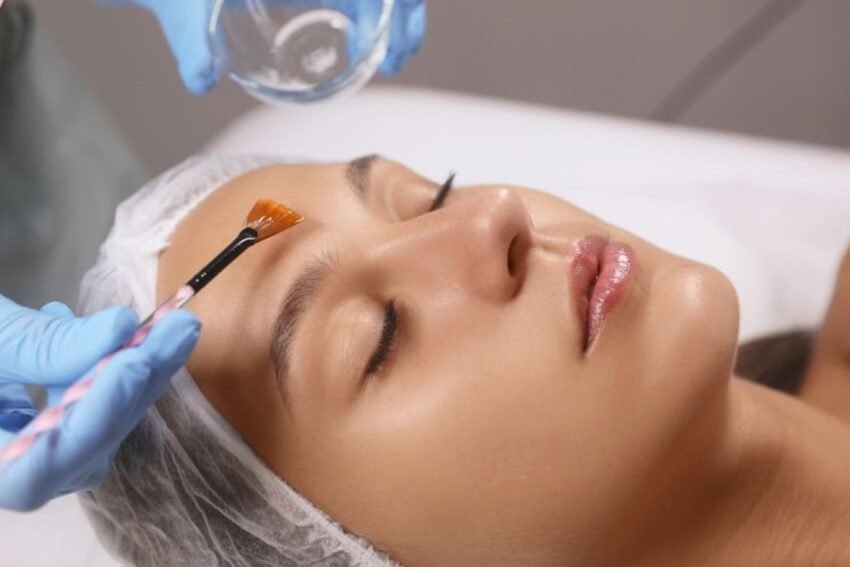Chemical Peel
Chemical Peel Treatment
Chemical peel treatment is a popular dermatological procedure used to improve the appearance of the skin by exfoliating its outer layers. This treatment can address a variety of skin concerns, including acne scars, hyperpigmentation, fine lines, and uneven skin texture. Chemical peels come in different strengths and formulations, tailored to the specific needs and skin types of patients.
At Skin Totale Med Spa, we are dedicated to helping you achieve healthy, radiant skin. Our team of expert dermatologists and skincare professionals brings years of experience to provide the best solutions for a variety of skin concerns. Choose Skin Totale Med Spa for a personalized skincare experience and achieve the radiant, healthy skin you deserve.

Types of Chemical Peels
Superficial Peels:
- Mild Exfoliation: These peels use mild acids, such as alpha-hydroxy acids (AHAs) or beta-hydroxy acids (BHAs), to gently exfoliate the outermost layer of skin.
- Minimal Downtime: Ideal for improving mild skin discoloration and rough texture with minimal downtime.
Medium Peels:
- Deeper Penetration: Medium peels typically use trichloroacetic acid (TCA) or glycolic acid to penetrate the middle layers of the skin.
- Moderate Downtime: Effective for treating fine lines, age spots, and moderate discoloration, with some recovery time required.
Deep Peels:
- Intensive Treatment: Deep peels use stronger acids, such as phenol, to deeply penetrate the skin layers.
- Significant Downtime: Suitable for treating deep wrinkles, severe sun damage, and pronounced discoloration, with a longer recovery period.
Key Components
- Acid Application: The selected chemical solution is applied to the skin, causing controlled exfoliation of the outer layers.
- Peeling Process: The skin peels off over the course of several days to weeks, revealing fresher, smoother skin underneath.
Skin Renewal:
- Cell Turnover: The peeling process stimulates cell turnover, promoting the growth of new, healthy skin cells.
- Collagen Production: Chemical peels can also stimulate collagen production, improving skin elasticity and firmness.
Customization:
- Tailored Treatment: The type and strength of the peel are customized based on the patient’s skin type, concerns, and desired results.
Benefits of Chemical Peel Treatment
- Improved Skin Texture: Smoothens rough skin texture, making the skin appear more refined and even.
- Reduced Hyperpigmentation: Lightens dark spots, age spots, and melasma, resulting in a more uniform skin tone.
- Acne and Scar Reduction: Helps to clear acne and reduce the appearance of acne scars.
- Fine Line and Wrinkle Reduction: Minimizes fine lines and wrinkles, providing a more youthful appearance.
- Enhanced Radiance: Reveals fresher, brighter skin, giving a radiant and rejuvenated look.
- Boosted Collagen Production: Promotes collagen synthesis, improving skin elasticity and firmness.
Treatment Process
- Consultation: A thorough assessment of the patient’s skin type, concerns, and medical history is conducted to determine the appropriate type and strength of the chemical peel.
- Preparation: The skin is cleansed to remove any makeup, oil, or impurities. A pre-peel solution may be applied to ensure even penetration of the chemical solution.
- Application: The chemical solution is carefully applied to the skin. The duration and number of layers applied depend on the type of peel and the desired depth of treatment.
- Neutralization: For certain peels, a neutralizing solution is applied to stop the chemical reaction. This step may not be necessary for all types of peels.
- Aftercare: The skin is treated with soothing creams and sunscreen. Patients are given post-treatment care instructions to ensure proper healing and optimal results.
Post-Treatment Care
- Moisturize: Regularly apply moisturizer to keep the skin hydrated and aid in the healing process.
- Avoid Sun Exposure: Protect the skin from direct sun exposure and use a broad-spectrum sunscreen to prevent hyperpigmentation and sun damage.
- Avoid Picking: Do not pick or peel off the skin as it heals, to prevent scarring and infection.
- Follow-Up: Attend follow-up appointments as recommended by the skincare professional to monitor progress and address any concerns.
Conclusion
Chemical peel treatment offers a versatile and effective solution for a wide range of skin concerns. By promoting exfoliation and skin renewal, chemical peels can enhance skin texture, tone, and overall appearance. With different types and strengths available, chemical peels can be tailored to meet individual needs, making them a popular choice for achieving radiant, youthful skin.
